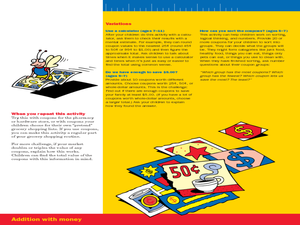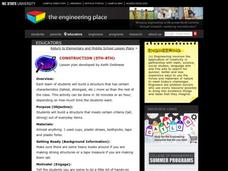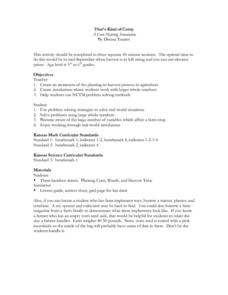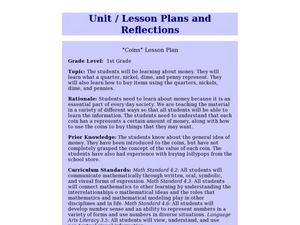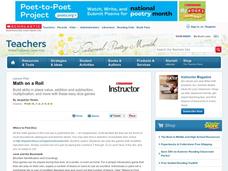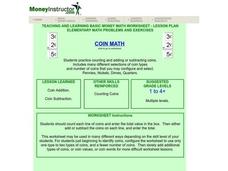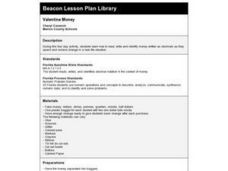Discovery Education
Architects in Action
Hands-on and real-world applications are great ways to teach mathematical concepts. Creative thinkers examine how ratios are used to create scale models of buildings and structures. They practice working with ratios by looking at a map...
Curated OER
Cool Cookie Math
Second graders identify the value of coins and make change from a dollar using different amounts. They are given story problems and use a fake shop in which they can buy things in which they have to determine how much change they would...
Curated OER
How Much Do We Save?
Students use coupons to save. In this saving lesson students practice their addition, multiplication and estimating skills with dollars and cents. They investigate grocery coupons and look for ways to save money.
Curated OER
Money Makes the World Go Around
Students convert currency from around the world. In this math instructional activity, students solve exchange rate problems using Google Earth. They complete a worksheet during the simulation.
EngageNY
Piecewise and Step Functions in Context
Looking for an application for step functions? This activity uses real data to examine piecewise step functions. Groups create a list of data from varying scenarios and create a model to use to make recommendations to increase revenue.
Illustrative Mathematics
Coupon Versus Discount
All too often stores give coupons for an item, but when you go into buy it, the item is on discount. The store won’t take the coupon if the discount is used. So what do you do, use the coupon or take the discount? This activity helps...
North Carolina State University
Construction
Engineering design projects serve as great opportunities for collaborative problem solving. In this case, learners work in small groups designing, building, and eventually testing a structure that meets a teacher-specified objective. It...
Curated OER
Who's On First?
Have you ever considered why the number 10 is so important to us? That's what learners do here. They explore patterns formed by powers of ten and by decimals, convert units of measure within the metric system, and express these in the...
Curated OER
Variance and Covariance: How much to do baseball players really make?
Is baseball really the road to riches? Here, statisticians look at salary data from baseball players and use variance to measure the spread of the data to more accurately answer that question. Note: The salary data provided is from 1994,...
Curated OER
Solve Story Problems: Sold! A Mathematics Adventure
Young mathematicians listen to the book Sold!: A Mathematics Adventure by Nathan Zimelman where they encounter ways to solve story problems. They then create and solve start unknown addition and subtraction equations. Resource builds in...
Curated OER
That's Kind of Corny!
Students apply math skills to determining how much corn seed to plant in 100 acres. They compute the amount of weed killer needed and after totaling how many bushels per acre they harvest, they calculate their profits.
Curated OER
Buying in Bulk
Students investigate buying purchases in bulk. In this buying in bulk lesson, students consider ways to cut costs and reduce waste in landfills by making bulk purchases.
Alabama Learning Exchange
No More Money Trouble
Young consumers explore money identification and counting. In this cross-curricular money instructional activity, they participate in comprehension and writing activities prior to and after reading the book Money Trouble by Bill Cosby....
Curated OER
Medieval Money
Students investigate the history of money as it was back then compare to now. In this algebra lesson, students analyze the type of money used in medieval times, the value of the currency and the coins used. They make a budget using...
Curated OER
Building Tolerance for Poverty in Math
Students explore approximate and exact solutions. In this interdisciplinary instructional activity, 6th graders will be placed in 'family groups' to create a budget that is subject to random events as chosen from the 'things happen' box....
Curated OER
Coins Lesson Plan
First graders identify different coins and use their values in combination with each other to buy different objects. In this coins lesson plan, 1st graders identify the value of a quarter, dime, nickel, and penny, and use them to buy items.
Curated OER
Managing My Money
Second graders use The Berenstain Bears' to learn about money management. In this money management lesson, 2nd graders read The Berenstain Bears' Dollars and Sense book and complete the 'Rainy Day' worksheet. Students then discuss the...
Curated OER
Teaching Money
Students identify coin/money values, write amounts of money and calculate change. The poem, "Smart" by Shel Silverstein is used in this lesson.
Curated OER
Math on a Roll
Students practice various math skills using a polyhedral die. In this dice game lesson, students practice multiplication, addition, place value, and money using games. Standard dice may be used instead of a polyhedral die with...
Curated OER
Keeping Track of Our Money
Second graders complete activities to learn how to manage money. In this managing money lesson plan, 2nd graders read the book How the Second Grade Got $8,205.50 to Visit the Statue of Liberty and complete two related worksheets.
Curated OER
WHY DOES MONEY HAVE VALUE?
Students learn that money has value by examining the history, meaning of money. market structures and pricing. In this analysis lesson plan, students use exchange rates to find the cost of an item different currencies.
Curated OER
Currency and Exchange Rates
Fifth graders share the book, "The Story of Money" and discuss the uses of money, bartering, trade and the history of money. Students discuss various ways of spending: cash, check, debit/credit cards and review the check writing process....
Curated OER
Counting Coins
Students practice counting and adding or subtracting coins. The lesson includes many different selections of coin types and number of coins that you may configure and select. Pennies, Nickels, Dimes, Quarters are the coins used.
Curated OER
Valentine Money
Third graders identify money as decimals. They spend and receive change in a real-life situation.




